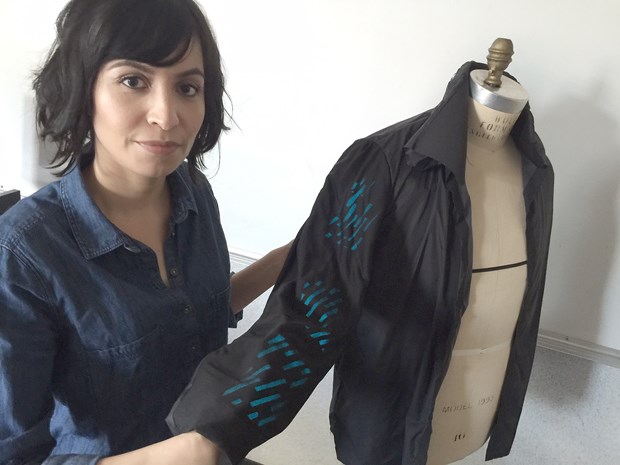Eva Garcia Mockford is shedding light on a new fashion idea.
The design student at KPU’s Richmond campus is using her research to not only have her creations emit light, she is also exploring the possibilities that one day our clothing will be “smart.”
Mockford, 36, said she envisions a day, in the not too distant future, perhaps within five years, when a jacket with embedded, wearable electronics would be able to communicate with other devices around it.
“Your jacket might be able to keep you safe when you walk the streets,” she said, “by talking to a driverless car, telling it that you are crossing the street and that it has to stop for you.”
If that sounds like too much science fiction, Mockford said it’s not as advanced as you may think.
The research she has been doing to develop a cycling jacket that has light emitting panels as part of the garment, has led her to explore the future where other types of electronics — such as an array of tiny sensors — can become part of the garment.
She said the applications can go in almost any direction, but the increasingly low cost of electronic sensors could see them being used effectively in healthcare settings for tasks such as monitoring and relaying a patient’s vital signs from remote locations inside a healthcare setting, or even from home.
It could usher in a whole new world of intelligent textiles, Mockford said, whose major, term-end project as a graduating student at KPU’s Wilson School of Design, is her Lumen Jacket.
The jacket is made from lightweight Gore-Tex — a material that allows it to be waterproof and breathable — that features a series of laser cut panels along the arms and at the base of the neck.
Shining through the small panels are thin sheets of electroluminescent materials, similar to those used in flat panel night lights, although these are flexible so they don’t inhibit body movements.
When lit — the panels are hooked up to a small battery pack — they emit a soft blue light. When turned off, they disappear.
Mockford said she is working on a way to get a power source that is much less bulky than the AA size batteries it currently uses. Cellphone technology, which uses lithium ion batteries is one option.
Aside from exploring the offshoot to “smart wear” Mockford said she was looking to design a cycling jacket that would appeal to varying types of consumers. During her research, she identified three distinctly different groups of riders. The first was those who bought into the world of cycling and came fully “kitted out” with clothing and equipment for their two-wheeled commute and did not mind how they appeared.
The second group was a little less gung-ho and preferred their attire to be a little more subdued. And the third group was reluctant to buy into the cycling culture and its associated garments and took to the streets as they would on a normal day without a bike under them.
But, in short, whichever group people belong to, there are a lot of cyclists, and potential customers, out there.
According to Statista, an online marketing firm, there were 46.6 million cyclists in the U.S. in 2013. And the National Bicycle Dealers Association in the U.S. pegged sales of bikes and related equipment in 2014 at $6.1 billion.
Mockford said her jacket design would most likely appeal to “early adopters,” those who were keen cyclists looking for the next advance in rider wear to add to their wardrobe. She also believes the middle group would be enticed by the way the jacket “hides” the light panels under a sheer top layer of material so that the luminescent areas are only visible when turned on.
She’s also been experimenting with black reflective strips manufactured by 3M that create a more subdued look than the more traditional silver-coloured tape which can deter more conservative, fashion-conscious buyers.
To help guide her design, Mockford applied her past degrees in sociology and visual arts. She also connected with MIT’s (Massachusetts Institute of Technology) media lab where she attended the university’s Disrupting Mobility Global Summit and Design Hackathon.



